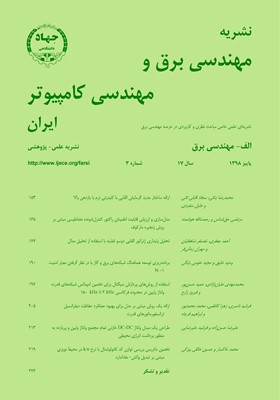تخمین ماتریس بررسی توازن کد کانولوشنال با نرخ k/n در محیط نویزی مبتنی بر تبدیل والش- هادامارد
محورهای موضوعی : مهندسی برق و کامپیوترمحمد خاکسار 1 , حسین خالقی بیزکی 2 *
1 - دانشگاه صنعتی مالک اشتر تهران
2 - دانشگاه صنعتی مالک اشتر تهران
کلید واژه: رادیوی نرمافزاریکد کانولوشنالتخمین ماتریس بررسی توزانتبدیل والش- هادامارد,
چکیده مقاله :
یکی از چالشهای رادیوهای هوشمند برای تطبیق خود با استانداردهای شبکه، تخمین کور پارامترهای ارسال و دریافت لایه فیزیکی است. این پارامترها میتوانند شامل نرخ ارسال، مدولاسیون و شیوه کدگذاری اطلاعات برای مقابله با خطای کانال باشند. از این رو تخمین کد کانال، شامل پارامترهای کد، ماتریس بررسی توازن و ماتریس مولد، یکی از مسایل مطرح در زمینه رادیوهای نرمافزاری است. عموماً تخمین کد با استفاده از روشهای جبری مانند روش اقلیدسی و روشهای مبتنی بر محاسبه مرتبه بر روی رشتهبیت دریافتی انجام میگیرد. اشکال عمده این روشها، کارایی ضعیف آنها در محیطهای نویزی است. یک روش برای حل مسأله تخمین کد، استفاده از روشهای مبتنی بر تبدیل، مانند تبدیل والش- هادامارد میباشد. در این مقاله، الگوریتم جدیدی بر مبنای تبدیل والش- هادامارد برای بازسازی ماتریس بررسی توازن کد کانولوشنال با نرخ دلخواه k/n در شرایط نویزی بالا، یعنی کانال BSC با 07/0 Pe>ارائه میشود که دارای کارایی به مراتب بهتری نسبت به روشهای قبلی است. در این الگوریتم با بهرهجستن از ویژگیهای جبری کد کانولوشنال، یک دستگاه معادلات با k-n معادله مستقل برای تخمین سطرهای ماتریس بررسی توازن، ایجاد شده و سپس با استفاده از تبدیل والش- هادامارد، معادلات به دست آمده حل میشوند. نتایج شبیهسازی از عملکرد مناسب روش پیشنهادی در شرایط نویزی بالا حکایت دارد.
Blind estimation of Physical layer transmission parameters, is one of the challenges for smart radios to adapt itself to network standards. These parameters could be transmission rate, modulation and coding scheme that is used for combating with channel errors. Therefore, Channel Coding Estimation, including code parameters, parity check matrix and generator matrix estimation, is one the interesting research topics in the context of software radios. Algebraic methods like Euclidean methods and Rank-based methods are usually performed on intercepted received sequence to estimate the code. Poor efficiency in a high error probability environment is the main drawback of this methods. Transform-based methods, like Walsh-Hadamard transform is one of the methods that could solve channel coding estimation problem. In this paper, new algorithm based on Walsh-Hadamard Transform is proposed that could reconstruct the parity check matrix of convolutional code with general k/n rate in a high error probability environments (BER>0.07), that has much better performance compared to other methods. This algorithm exploits algebraic properties of convolutional code in order to form k-n equation for estimation of k-n rows of the parity check matrix and then use Walsh-Hadamard transform to solve these equations. Simulation results verified excellent performance of the proposed algorithm in high error probability environments compared to other approaches.
[1] B. Rice, "Determining the parameters of a rate 1/n convolutional encoder over GF(q)," in Proc. 3rd Int. Conf. on Finite Fields and Applications, 4 pp., Glasgow, USA, Jul. 1995.
[2] E. Filiol, "Reconstruction of convolutional encoders over GF(q)," in Proc. 6th IMA Int. Conf. on Cryptography and Coding, pp. 101-109, Cirencester, UK, 17-19 Dec. 1997.
[3] J. Barbier, G. Sicot, and S. Houcke, "Algebraic approach for the reconstruction of linear and convolutional error correcting codes," International Journal of Applied Mathematics and Computer Science, vol. 2, no. 3, pp. 113-118. Nov. 2006.
[4] M. Cote and N. Sendrier, "Reconstruction of convolutional codes from noisy observation," in Proc. IEEE Int. Symp. on Information Theory, ISIT'09, pp. 546-550, Seoul, South Korea, 28 June-3 Jul. 2009.
[5] A. Valembois, "Detection and recognition of a binary linear code," Discrete Applied Mathematics, vol. 111, no. 1-2, pp. 199-218, Jul. 2001.
[6] F. Wang, Z. Huang, and Y. Zhou, "A method for blind recognition of convolution code based on euclidean algorithm," in Proc. Int. Conf. on Wireless Communications, Networking, and Mobile Computing, WiCom'07, pp. 1414-1417, Shanghai, China, 21-25 Sept. 2007.
[7] J. Dingel and J. Hagenauer, "Parameter estimation of a convolutional encoder from noisy observations," in Proc. IEEE Int. Symp. on Information Theory, ISIT'07, pp. 1776-1780, Nice, France, 24-29 Jun. 2007.
[8] M. Marazin, R. Gautier, and G. Burel, "Blind recovery of k/n rate convolutional encoders in a noisy environment," EURASIP J. on Wireless Communications and Networking, vol. 2011, no. 168, Article, 9 pp., Nov. 2011.
[9] A. Gholizadeh Soteh and H. Khaleghi Bizaki, "On the analytical solution of rank problem in the convolutional code identification context," IEEE Communications Letters, vol. 20, no. 3, pp. 442-445, Jan. 2016.
[10] J. Liu, X. J. Wang, and X. Y. Zhou, "Blind recognition of convolutional coding based on Walsh-Hadamard transform," J. of Electronics and Information Technology, vol. 32, no. 4, pp. 884-888, Apr. 2010.
[11] F. Wang, H. Xie, and Z. Huang, "Blind reconstruction of convolutional code based on segmented Walsh-Hadamard transform," J. of Systems Engineering and Electronics, vol. 25, no. 5, pp. 748-754, Nov. 2014.
[12] ح. خالقی بیزکی، نظریه کدگذاری کانال، انتشارات دانشگاه صنعتی مالک اشتر، چاپ دوم، فروردین 1394.
[13] G. Forney, "Structural analysis of convolutional codes via dual codes," IEEE Trans. on Information Theory, vol. 19, no. 4, pp. 512-518, Jul. 1973.
[14] T. Beer, "Walsh Transforms," American J. of Physics, vol. 49, no. 5, pp. 466-472, May 1981.

